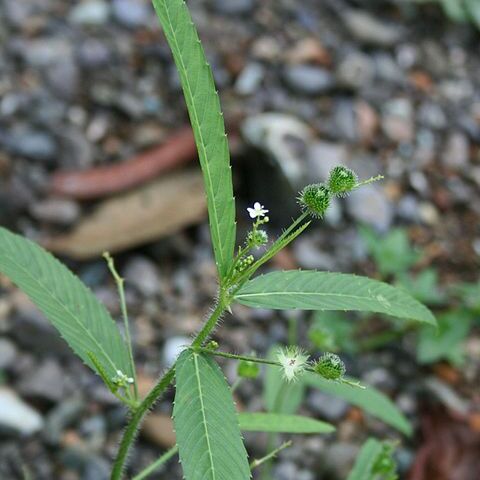Herbs [subshrubs], annual [perennial], monoecious [rarely dioecious]; hairs unbranched, sometimes glandular; latex absent. Leaves alternate, simple; stipules present, persistent; petiole present, glands absent; blade unlobed, margins serrate, laminar glands absent; venation pinnate or weakly palmate at base, pinnate distally, secondary veins straight, closely spaced, and parallel [arched, moderately spaced]. Inflorescences bisexual (pistillate flowers proximal, staminate distal) [unisexual], axillary, spikes or racemes; glands subtending each bract 0. Pedicels present or absent. Staminate flowers: sepals 5, valvate, connate basally; petals 5, distinct, adnate to base of staminal column, white; nectary absent; stamens 10, in 2 whorls, connate basally; pistillode present, at top of staminal column. Pistillate flowers: sepals persistent, often enlarging in fruit, 5–8(–10), connate basally, unequal, small outer lobes often present alternating with larger lobes; petals 5(–6) [often rudimentary], distinct, white; nectary absent; pistil 3-carpellate; styles 3, connate basally [distinct], deeply multifid, branches [9–]12–21 per flower. Fruits capsules, densely muricate. Seeds subglobose; caruncle absent. x = 11.
Herbs, annual or perennial, sometimes rhizomatous or suffruticose; monoeci-ous (in Panamanian species). Leaves alternate, petiolate, stipulate; blade pin-nately or palmately veined, margin serrate. Inflorescences axillary, usually bisexual, racemiform or spiciform, with 1-5 basal pistillate and several distal staminate flowers; bracts subtending solitary flowers. Staminacte flowers with pedicels articu-late; calyx usually 5-lobed, valvate in the bud; petals 5, often unequal, basally adnate to the staminal column; disc absent; stamens 10, in 2 superposed whorls of 5, the anthers dehiscing longitudinally; pollen grains-+ oblate-spheroidal, reticulate, 6-colporate (in Panamanian species), germ pores large; pistillode present. Pistillate flowers sessile or sometimes short-pedicellate; calyx-lobes typically 5, with 0-5 smaller supernumerary lobes; disc obsolete; ovary of 3 carpels, muricate and sometimes hispidulous as well, the ovules 1 per locule, the styles 3, ? deeply 3-7-lobed. Fruits capsular, verruculose; seeds spheroidal, ecarunculate, minutely foveolate, with narrow raphe, the endosperm copious, the cotyledons broader than radicle.
Male flowers shortly pedicellate; calyx closed in bud, later splitting, at least partially, into 5 valvate lobes; petals 5, imbricate, free, subequal or unequal, inserted on the staminal column; disk absent; stamens 10, rarely fewer, partially fused into a column, biseriate, anthers introrse, medifixed, 2-celled, longitudinally dehiscent; pistillode cylindric, entire or 3-lobed, situated at the top of the staminal column.
Female flowers shortly pedicellate to subsessile; sepals 5–10, imbricate, equal or unequal, accrescent; petals 5–6, free, imbricate, sometimes much reduced; disk absent; ovary sessile, 3-locular, with 1 ovule per loculus; styles 3, ± free or slightly connate at the base, deeply laciniate.
Seeds ovoid or globose, smooth, punctate or lineate, ecarunculate, but with a very thin closely adherent aril which may leave a false raphe; albumen fleshy; cotyledons broad, flat.
Leaves alternate, shortly petiolate, stipulate, simple, serrate, penninerved or sometimes palminerved; nerves craspedodromous.
Inflorescences axillary, spicate or racemose, pedunculate, distally male, proximally female; bracts small, 1-flowered.
Fruits 3-lobed, hispid or echinate, dehiscing septicidally into 3 bivalved cocci; endocarp thinly crustaceous.
Monoecious, rarely dioecious, annual or perennial herbs, usually of marshy places.
Indumentum simple, often hispid or glanduliferous.

